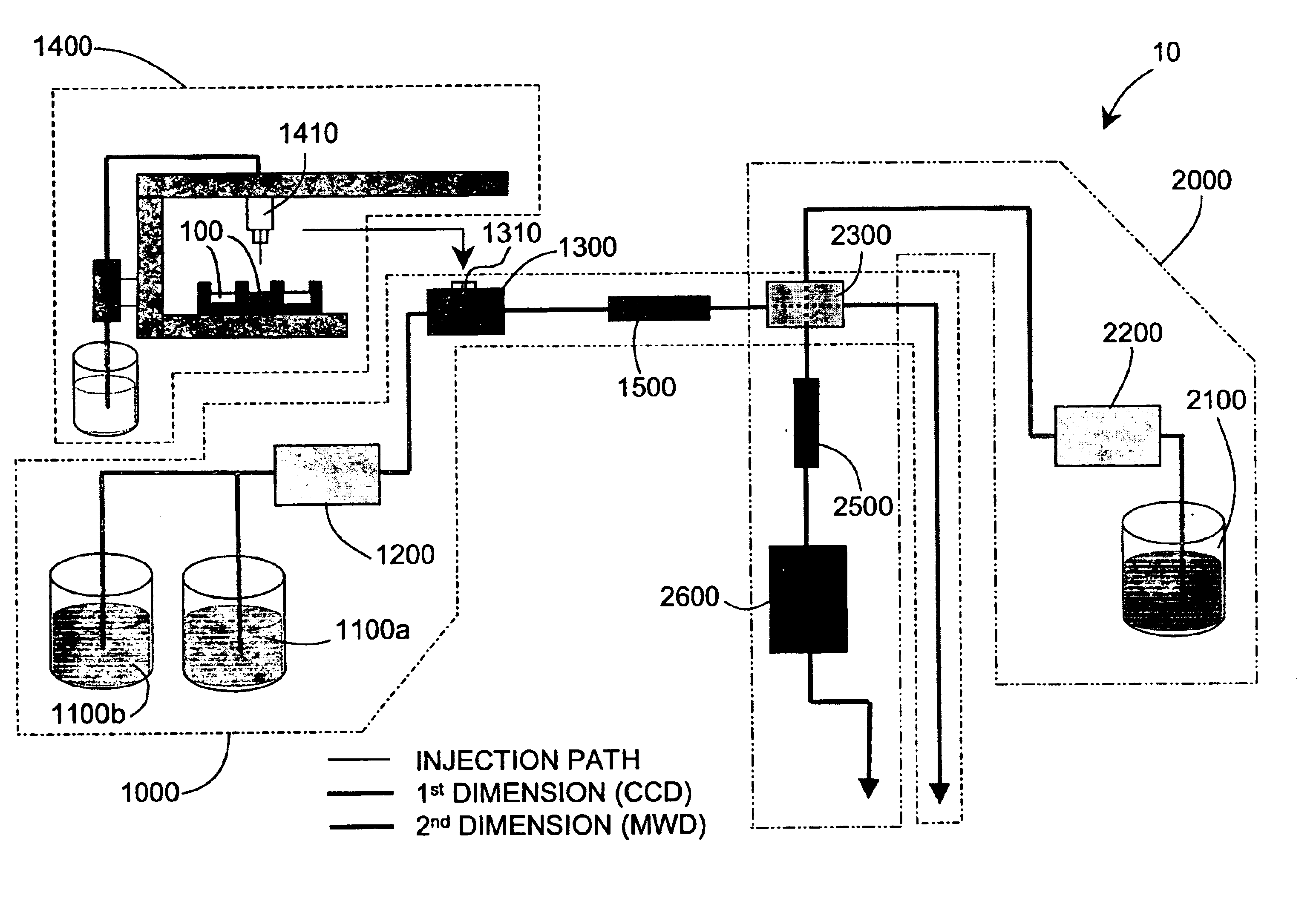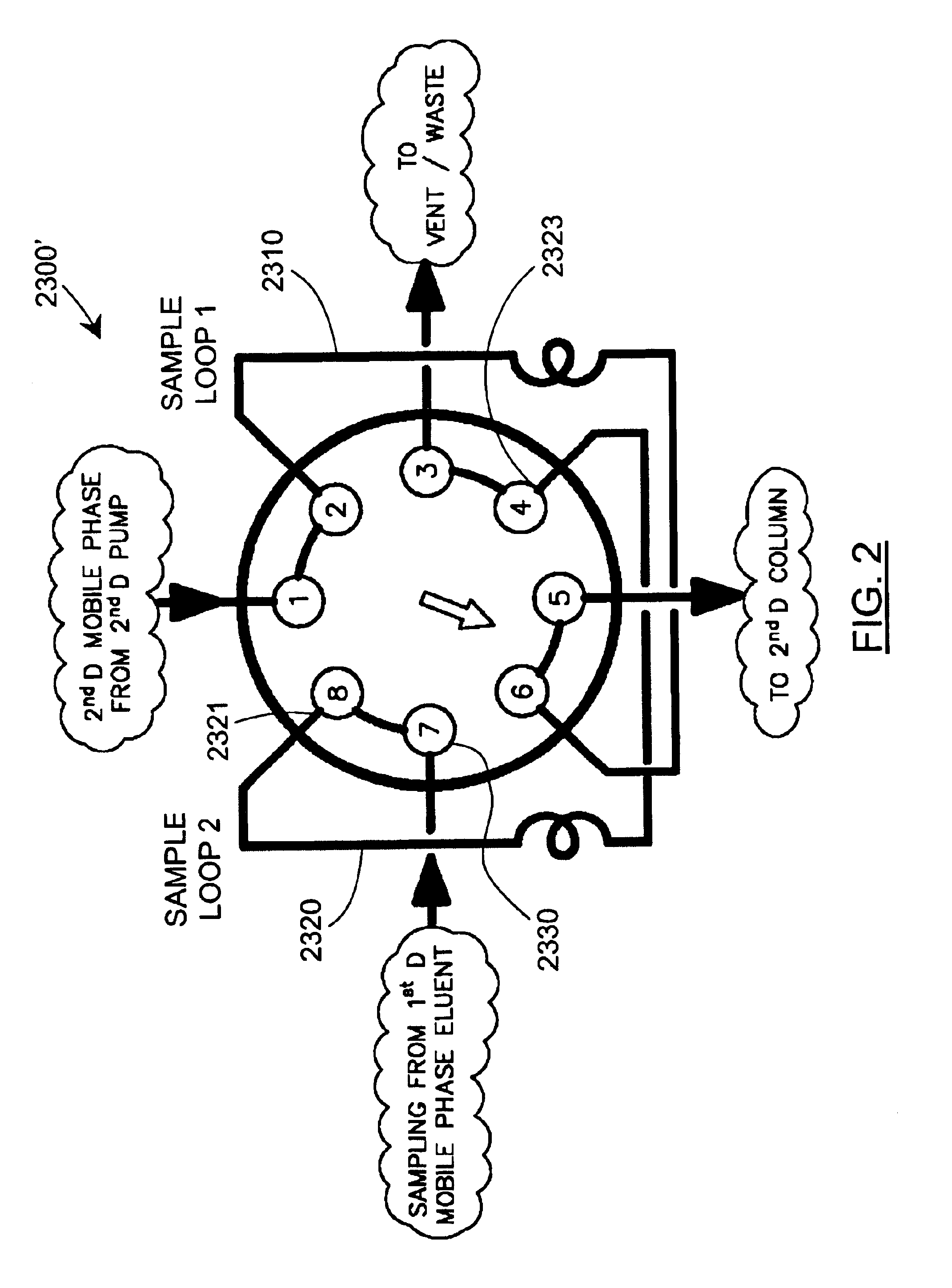Rapid characterization of polymers
a polymer and sample technology, applied in chemical/physical processes, biological material analysis, sedimentation separation, etc., can solve the problems of inefficiency with respect to the overall sample throughput, complicated control and/or operation schemes and systems, etc., and achieve the effect of less complicated
- Summary
- Abstract
- Description
- Claims
- Application Information
AI Technical Summary
Benefits of technology
Problems solved by technology
Method used
Image
Examples
example 1
Two-Dimensional Liquid Chromatography with Regularly Recurring 2nd-Dimension Sampling Interval
This example demonstrates two-dimensional liquid chromatography techniques for characterizing a polymer sample comprising polymer components of varying composition and / or molecular weight, wherein the second-dimension is comprehensively and directly coupled to the first dimension, by in-line sampling of the first-dimension mobile phase eluent at regularly recurring intervals of time.
In experiments effected for this example, various polymer samples (described below) having components with different chemical compositions and / or molecular weight were characterized in a two-dimension chromatography system comprising a first dimension HPLC subsystem adapted for normal-phase compositional gradient elution chromatography, and a second dimension HPLC subsystem adapted for gel permeation chromatography (GPC). Briefly, about 50 μL of a polymer sample solution was injected into the mobile phase of the...
example 2
Use of 2-Dimensional Liquid Chromatography for Fingerprinting Characterization of a Combinatorial Library of Polymer Samples
This example demonstrates two-dimensional liquid chromatography techniques as applied for characterizing a combinatorial library of polymer samples comprising polymer components of random copolymers, poly(AB), synthesized by free-radical polymerization in a parallel batch reactor with various ratios of monomers A and B, and with varying ratios of monomer to initiator. This example also demonstrates that such two-dimensional characterization protocols are comparable in quality of results to separate, one-dimensional analysis conducted independently of each other, and favorable in terms of overall sample throughput.
The polymer samples of the library were synthesized in the parallel batch reactor using combinatorial polymerization approaches known in the art. FIG. 7A is a graphical representation of the library design for the library of polymer samples, showing th...
example 3
Comparative Characterization Using 2-Dimensional Liquid Chromatography versus Using Separate, One-Dimension HPLC and GPC Analysis, for Fingerprinting Characterization of a Combinatorial Library of Polymer Samples
This example demonstrates a comparison between two-dimensional liquid chromatography techniques, and corresponding separate, individual one-dimensional liquid chromatography protocols, as applied for characterizing a combinatorial library of polymer samples. The library of polymer samples comprises polymer components of random copolymers, poly(AB), synthesized by free-radical polymerization in a parallel batch reactor with various ratios of monomers A and B, and with varying ratios of monomer to initiator, where A and B represent hydroxyethylmethacrylate (HEMA) and styrene monomers, respectively.
The polymer samples of the library were synthesized in the parallel batch reactor using combinatorial polymerization approaches known in the art. FIG. 8A is a graphical representatio...
PUM
| Property | Measurement | Unit |
|---|---|---|
| volumes | aaaaa | aaaaa |
| volumes | aaaaa | aaaaa |
| volume | aaaaa | aaaaa |
Abstract
Description
Claims
Application Information
 Login to View More
Login to View More - R&D
- Intellectual Property
- Life Sciences
- Materials
- Tech Scout
- Unparalleled Data Quality
- Higher Quality Content
- 60% Fewer Hallucinations
Browse by: Latest US Patents, China's latest patents, Technical Efficacy Thesaurus, Application Domain, Technology Topic, Popular Technical Reports.
© 2025 PatSnap. All rights reserved.Legal|Privacy policy|Modern Slavery Act Transparency Statement|Sitemap|About US| Contact US: help@patsnap.com



